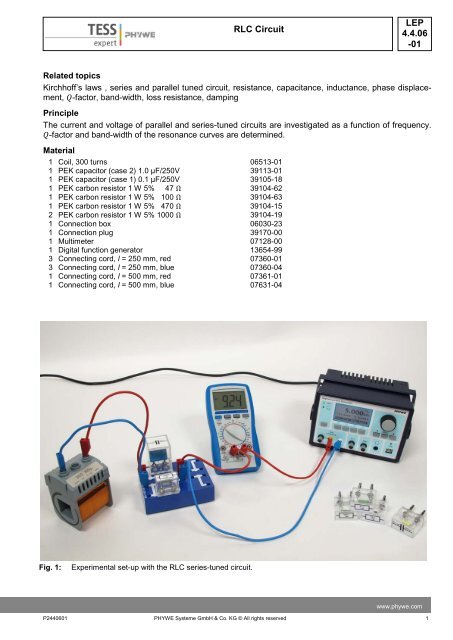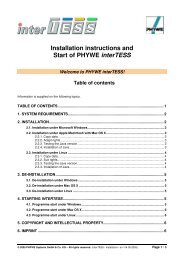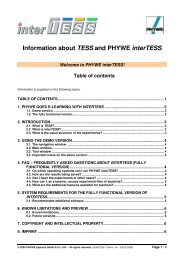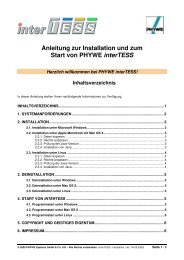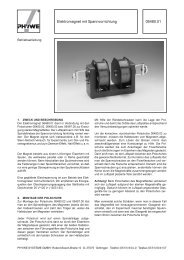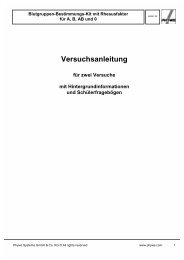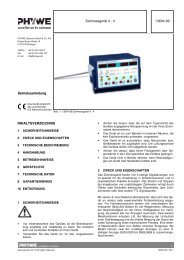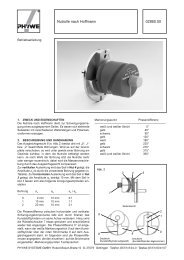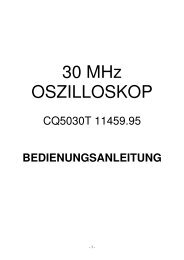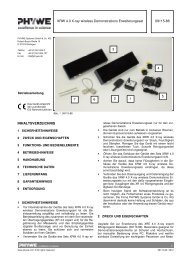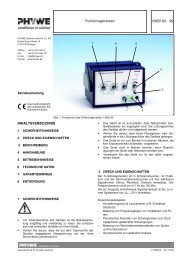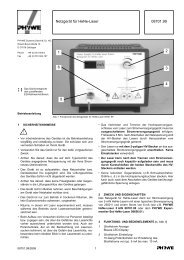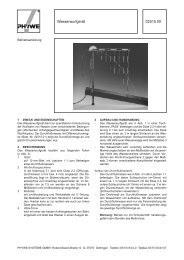LEP 4.4.06 -01 RLC Circuit - Phywe Systeme GmbH
LEP 4.4.06 -01 RLC Circuit - Phywe Systeme GmbH
LEP 4.4.06 -01 RLC Circuit - Phywe Systeme GmbH
You also want an ePaper? Increase the reach of your titles
YUMPU automatically turns print PDFs into web optimized ePapers that Google loves.
<strong>RLC</strong> <strong>Circuit</strong><br />
<strong>LEP</strong><br />
<strong>4.4.06</strong><br />
-<strong>01</strong><br />
Related topics<br />
Kirchhoff’s laws , series and parallel tuned circuit, resistance, capacitance, inductance, phase displacement,<br />
𝑄-factor, band-width, loss resistance, damping<br />
Principle<br />
The current and voltage of parallel and series-tuned circuits are investigated as a function of frequency.<br />
𝑄-factor and band-width of the resonance curves are determined.<br />
Material<br />
1 Coil, 300 turns 06513-<strong>01</strong><br />
1 PEK capacitor (case 2) 1.0 µF/250V 39113-<strong>01</strong><br />
1 PEK capacitor (case 1) 0.1 µF/250V 39105-18<br />
1 PEK carbon resistor 1 W 5% 47 Ω<br />
39104-62<br />
1 PEK carbon resistor 1 W 5% 100 Ω<br />
39104-63<br />
1 PEK carbon resistor 1 W 5% 470 Ω<br />
39104-15<br />
2 PEK carbon resistor 1 W 5% 1000 Ω<br />
39104-19<br />
1 Connection box<br />
06030-23<br />
1 Connection plug<br />
39170-00<br />
1 Multimeter 07128-00<br />
1 Digital function generator 13654-99<br />
3 Connecting cord, l = 250 mm, red 07360-<strong>01</strong><br />
3 Connecting cord, l = 250 mm, blue 07360-04<br />
1 Connecting cord, l = 500 mm, red 07361-<strong>01</strong><br />
1 Connecting cord, l = 500 mm, blue 07631-04<br />
Fig. 1: Experimental set-up with the <strong>RLC</strong> series-tuned circuit.<br />
www.phywe.com<br />
P24406<strong>01</strong> PHYWE <strong>Systeme</strong> <strong>GmbH</strong> & Co. KG © All rights reserved 1
TEP<br />
<strong>4.4.06</strong><br />
-<strong>01</strong><br />
<strong>RLC</strong> <strong>Circuit</strong><br />
Tasks<br />
Analyze the frequency performance of an<br />
1. series-tuned circuit for<br />
a. voltage resonance with 𝑅 𝑑 = 0 Ω.<br />
b. current resonance with 𝑅 𝑑 = 0 Ω, 47 Ω, 100 Ω.<br />
2. parallel-tuned circuit for<br />
a. current resonance with 𝑅 𝑑 = ∞.<br />
b. voltage resonance with 𝑅 𝑑 = 470 Ω, 1000 Ω, ∞.<br />
Set-up<br />
The experimental set-up is shown in Fig. 1.<br />
For the digital function generator select following settings:<br />
• DC-offset: ± 0 V<br />
• Amplitude: 3 to 4 V<br />
• Frequency: 0 - 30 kHz<br />
• Mode: sinusoidal<br />
None of the settings should be changed during the<br />
experiment.<br />
The circuit diagram for the series-tuned circuit is<br />
shown in Fig. 2, where 𝑅 𝑑 denotes the damping resistance.<br />
The equivalent diagram for the parallel-tuned<br />
circuit is shown in Fig. 3. A 1 kΩ resistor 𝑅 𝑘 is used<br />
for coupling the tuned circuit to the digital function<br />
generator.<br />
Fig. 2: Equivalent diagram for the series-tuned circuit.<br />
Procedure<br />
The multimeter must be set to AC mode. For measuring<br />
the voltage select the range up to 2 V. The<br />
range for the current should be 20 mA. In some<br />
cases it may be necessary to change the range to<br />
200 mA.<br />
In order to evaluate the quality of the resonance<br />
curves, the frequency generator’s internal resistance<br />
𝑅 𝑖 and the circuits’ loss resistances 𝑅 𝑣 have to<br />
be determined. To calculate the internal resistance<br />
of the function generator measure current and terminal<br />
voltage in the series-tuned circuit at the frequency<br />
of 0 Hz. For computing the loss resistances<br />
in both circuits measuring current and voltage at the<br />
resonance point is needed. In the case of the parallel-tuned<br />
circuit, the capacitors loss resistance can be ignored, as it amounts to several hundred MΩ .<br />
Fig. 3: Equivalent diagram for the parallel-tuned circuit.<br />
Task 1:<br />
a) To record the voltage resonance curve for the series-tuned circuit, the voltage across the tuned<br />
circuit is measured consecutively for both capacitances while passing through the frequency<br />
range.<br />
b) In the case of the current resonance the multimeter is connected as ammeter in the circuit and<br />
2 PHYWE <strong>Systeme</strong> <strong>GmbH</strong> & Co. KG © All rights reserved P24406<strong>01</strong>
<strong>RLC</strong> <strong>Circuit</strong><br />
<strong>LEP</strong><br />
<strong>4.4.06</strong><br />
-<strong>01</strong><br />
the frequency range is again traversed for three damping resistances 𝑅 𝑑 = 0 Ω, 47 Ω, 100 Ω and<br />
one capacitance.<br />
Task 2:<br />
a) For recording the current resonance curve in the parallel-tuned circuit, the total current is measured<br />
for both capacitances with the multimeter while traversing the frequency range.<br />
b) In the case of the voltage resonance curve, the voltage across the tuned circuit is measured for<br />
one capacitance with the multimeter and the frequency range is again traversed for the parallel<br />
resistances 𝑅 𝑑 = 470 Ω, 1000 Ω, ∞.<br />
Note: A change of the measuring range results in an altered internal resistance of the multimeter. This<br />
will lead to different values. Try to prevent such changes during measurements by choosing the measuring<br />
range according to the values at the resonance frequency.<br />
Theory<br />
Considering the tuned <strong>RLC</strong>-circuit one has to differ between series-tuned and parallel-tuned circuits. For<br />
the series-tuned circuit Kirchhoff’s second law states, that all potentials in one loop add to zero, see equation<br />
(1).<br />
𝑈 𝐿 + 𝑈 𝐶 + 𝑈 𝑅 − 𝑈 𝐺 = 0 (1)<br />
There 𝑈 𝐺 is the function generator’s potential, which has the opposite direction in respect to all other potentials.<br />
The potentials can be described as follows:<br />
𝑈 𝐶 = 𝑄<br />
𝐶<br />
𝑈 𝐿 = 𝐿 ∙ 𝑑<br />
𝑑𝑡 𝐼<br />
𝑈 𝑅 = 𝑅 ∙ 𝐼<br />
𝑈 𝐺 = 𝑈 0 ∙ 𝑒 𝑖𝜔𝑡<br />
As the time derivative of the charge 𝑄 gives the current 𝐼, insertion into (1) and differentiation gives relation<br />
(2).<br />
𝐿 ∙ 𝑑2 𝑑 𝐼<br />
𝑑𝑡 2 𝐼 + 𝑅 ∙ 𝐼 +<br />
𝑑𝑡 𝐶 = 𝑖𝜔𝑈 0 ∙ 𝑒 𝑖𝜔𝑡 (2)<br />
This equation can be transformed into the inhomogeneous differential equation for the forced oscillation<br />
as shown in relation (3). There 𝜔 0 = 1<br />
𝐿𝐶<br />
𝑅<br />
is the eigenfrequency and 𝛿 = the damping coefficient.<br />
2𝐿<br />
2 𝜔<br />
𝐼̈ + 2𝛿𝐼̇ + 𝜔 0𝐼 =<br />
𝐿 ∙ 𝑈 0 ∙ 𝑒 𝑖(𝜔𝑡+𝜋<br />
2 ) The real part of the solution for (3) gives the current<br />
(3)<br />
𝐼 = 𝐼 0 ∙ cos(ωt − φ) (4)<br />
with<br />
𝐼 0 =<br />
𝑈 0<br />
�𝑅 2 +�𝜔𝐿− 1<br />
. (5)<br />
�2<br />
𝜔𝐶<br />
The phase displacement 𝜑 is given by<br />
tan 𝜑 = − 1<br />
1<br />
∙ �𝜔𝐿 − �<br />
𝑅 𝜔𝐶<br />
and the resonance point is found at<br />
(6)<br />
𝜔 = 𝜔 0 = 1<br />
.<br />
√𝐿𝐶<br />
(7)<br />
www.phywe.com<br />
P24406<strong>01</strong> PHYWE <strong>Systeme</strong> <strong>GmbH</strong> & Co. KG © All rights reserved 3
TEP<br />
<strong>4.4.06</strong><br />
-<strong>01</strong><br />
<strong>RLC</strong> <strong>Circuit</strong><br />
In contrast to the mechanical oscillation, here the resonance frequency is independent of the dampening.<br />
As can be easily shown from relations (6) and (7), at the resonance point the phase displacement becomes<br />
zero in all components of the circuits.<br />
For the parallel-tuned circuit Kirchhoff’s first law is applied.<br />
𝐼 𝑅 + 𝐼 𝐿 + 𝐼 𝐶 − 𝐼 𝐺 = 0<br />
At the resonance point the current becomes minimal as most of the current circulates as reactive current<br />
in the circuit without flowing through the conductors.<br />
In order to evaluate the quality of the resonance curve the bandwidth 𝐵 of the resonance is calculated<br />
with<br />
𝐵 = 2|𝜔 𝑏 − 𝜔 0| (8)<br />
𝐼(𝜔 𝑏)<br />
𝐼(𝜔 0)<br />
1<br />
= . (9)<br />
√2<br />
With 𝜔 0 = 2𝜋 ∙ 𝜈 0 follows for the quality factor 𝑄 = 𝜐 0<br />
𝐵 .<br />
The quality factor can also be calculated directly from resistance, capacitance and inductance of the circuit.<br />
We obtain for the series-tuned circuit<br />
𝑄 𝑠 = 1<br />
∙ �𝐿<br />
𝑅 𝐶<br />
and for the parallel-tuned circuit<br />
𝑄 𝑝 = 𝑅 ∙ � 𝐶<br />
. (11)<br />
𝐿<br />
In both cases 𝑅 means the total resistance of the circuit. For the series connection and the parallel con-<br />
𝑠 𝑝<br />
nection we obtain 𝑅 𝑡𝑜𝑡 = 𝑅𝑖 + 𝑅 𝑣 + 𝑅 𝑑 and 𝑅 𝑡𝑜𝑡 = 𝑅𝑖 + 𝑅 𝑘 + 1<br />
respectively. The loss resistance in the<br />
1<br />
+<br />
𝑅 𝑑 1<br />
𝑅𝑣<br />
parallel circuit lies in series with the coil but is not, however, identical with the coil’s d.c. resistance. In our<br />
case, the coil’s d.c. resistance of 0.8 Ω can be disregarded.<br />
Results and Evaluation<br />
In the following the evaluation of the obtained values is described exemplary. Your results may vary from<br />
those presented here.<br />
Task 1: Analyze the frequency performance of a series-tuned circuit.<br />
For the internal resistance of the digital function generator 𝑅 𝑖 = 4.1 Ω was found. The loss resistance<br />
was determined at 𝜐 0 = 11 kHz with 𝑅 𝑙 = 16.4 Ω for the circuit with 𝐶 = 0.1 µF .<br />
Fig. 4 shows the resonance curves of the current for different resistances. The strong influence of the resistance<br />
on the quality of the resonance is obvious. The 𝑄-factors calculated from the bandwidth are given<br />
in Tab.1.<br />
Tab. 1: Current resonance curves: bandwidths and quality<br />
factors for the series-tuned circuit.<br />
resistance bandwidth quality factor<br />
0 Ω 2 kHz 5.5<br />
47 Ω 8 kHz 1.4<br />
100 Ω 11 kHz 1.0<br />
4 PHYWE <strong>Systeme</strong> <strong>GmbH</strong> & Co. KG © All rights reserved P24406<strong>01</strong><br />
(10)
<strong>RLC</strong> <strong>Circuit</strong><br />
<strong>LEP</strong><br />
<strong>4.4.06</strong><br />
-<strong>01</strong><br />
As had been shown in the theory-section, the eigenfrequency of a tuned circuit depends on the inductance<br />
as well as the capacity in the circuit. Fig. 5 displays that dependence for the voltage resonance in<br />
the series-tuned circuit.<br />
Fig. 5: Terminal voltage as a function of frequency in the series tuned circuit.<br />
Task 2: Analyze the frequency performance of a parallel-tuned circuit.<br />
A loss resistance of 1460 Ω was found for the parallel-tuned circuit. The 𝑄-factors determined from Fig. 6<br />
are listed in Tab. 2.<br />
Tab.: 2 Voltage resonance curves: bandwidths and quality<br />
factors for the parallel-tuned circuit.<br />
resistance bandwidth quality factor<br />
470 Ω 8 kHz 1.4<br />
1000 Ω 6 kHz 1.8<br />
∞ 4 kHz 2.8<br />
Fig. 7 shows the current resonance in the parallel-tuned circuit for the second capacitor.<br />
For the resonance frequencies the found values of 11 kHz and 3.25 kHz with 𝐶 = 0.1 µF and 𝐶 = 1.0 µF<br />
respectively agree within 5 %.<br />
www.phywe.com<br />
P24406<strong>01</strong> PHYWE <strong>Systeme</strong> <strong>GmbH</strong> & Co. KG © All rights reserved 5
TEP<br />
<strong>4.4.06</strong><br />
-<strong>01</strong><br />
<strong>RLC</strong> <strong>Circuit</strong><br />
Fig. 6: Voltage as a function of frequency in the parallel-tuned circuit.<br />
Fig.: 7 Current as a function of frequency in the parallel-tuned circuit.<br />
6 PHYWE <strong>Systeme</strong> <strong>GmbH</strong> & Co. KG © All rights reserved P24406<strong>01</strong>


